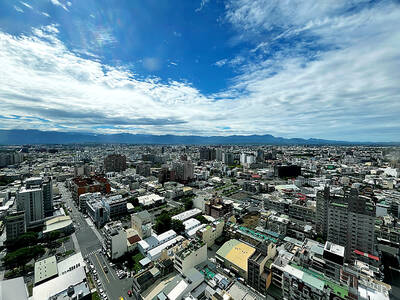The first “Made in Taiwan” wind turbine blades would be ready for shipping in the third quarter of next year, Danish wind turbine manufacturer MHI Vestas Offshore Wind A/S said on Thursday.
Tienli Offshore Wind Power Technology Co’s (天力離岸風電科技) turbine blade factory in Taichung would be the first such manufacturing plant in the Asia-Pacific region outside of China, Bjarne Jorgensen, project director at MHI Vestas Offshore Wind Taiwan Ltd (台灣菱重維特斯離岸風電), told a news conference in Taipei.
MHI Vestas’ cooperation with Tienli and another Danish firm, Copenhagen Infrastructure Partners K/S (CIP), are part of its localization efforts, he said, adding that construction of the factory would be completed in June next year.

Photo courtesy of Tienli Offshore Wind Power Technology Co
“We will ramp up with a slow and steady learning curve until 2022, when we will reach top capacity of four blades a week,” Jorgensen said, adding that the Taichung facility features storage space for up to 120 blades.
“We will bring all the equipment related to the manufacturing of the turbine blades, from molds and injection machines to hanging and installation tools,” Jorgensen said. “We will bring mature European technology to Taiwan. It will definitely be localized.”
Blade manufacturing is a very sophisticated process, as any deviation in the giant blades would cause enormous stress on the material, he added.
Dennis Sanou, chief executive officer of CIP’s Changfang (彰芳) and Xidao (西島) wind farms, said that CIP has fulfilled and exceeded the government’s local production requirements.
“Changfang and Xidao only need to produce 15 blades locally [to meet the Industrial Development Bureau requirements], but we have decided to make all 190 in Taiwan,” Sanou said. “Once our Chong Neng (中能) wind farm project reaches a financial close, that number will be raised to 300.”
Unlike other offshore wind farm developers that have difficulties fulfilling the requirements, CIP has embraced the government policy, which attracts international developers with feed-in tariffs while demanding that they utilize made-in-Taiwan components.
“We are of the opinion that the only sustainable way to set up business is to support localization and invest back into the country,” Sanou said. “Of course, this costs money, but as the supply chain matures, we will see efficiency going up and defects going down, just like it did in Europe.”
In return, Sanou urged the government to commit to allocating more capacity to offshore wind farms.
“To maximize localization, it is very important for Taiwan to lock in more offshore wind capacity,” he said. “These two things must go hand in hand to justify the investment of developers and manufacturing partners.”
A total of 27 categories of components are subject to the localization requirements, a number that might increase or decrease for phase 3 of the offshore wind farm development plan that is being prepared by the Bureau of Energy.
“Tienli has the potential to become a turbine blade exporter and the pride of Taiwan,” Sanou said.
However, catering to projects with a total capacity of 900 megawatts, the approximate combined capacity of the Changfang, Xidao and Chong Neng wind farms, is “not enough to be a sustainable pipeline” for Tienli, Sanou said.
He did not elaborate on a capacity of projects that would allow Tienli to break even or the company’s road map for exporting turbine blades.
“I cannot give you numbers and this is not the meeting to disclose” such numbers, he said.
“Many factors are at play. But in Europe, prices were high in the beginning, too. Once the market is developed in Taiwan it is expected that the price will go down as well,” he added.
Tienli’s Taichung facilities would employ 350 people, MHI Vestas said in a press release.
The area’s “blade ecosystem,” which also includes Swancor Holding Co (上緯), would create value of NT$4 billion (US$140.65 million) between next year and 2024, the press release said.

BYPASSING CHINA TARIFFS: In the first five months of this year, Foxconn sent US$4.4bn of iPhones to the US from India, compared with US$3.7bn in the whole of last year Nearly all the iPhones exported by Foxconn Technology Group (富士康科技集團) from India went to the US between March and last month, customs data showed, far above last year’s average of 50 percent and a clear sign of Apple Inc’s efforts to bypass high US tariffs imposed on China. The numbers, being reported by Reuters for the first time, show that Apple has realigned its India exports to almost exclusively serve the US market, when previously the devices were more widely distributed to nations including the Netherlands and the Czech Republic. During March to last month, Foxconn, known as Hon Hai Precision Industry

Taiwan Semiconductor Manufacturing Co (TSMC, 台積電) and the University of Tokyo (UTokyo) yesterday announced the launch of the TSMC-UTokyo Lab to promote advanced semiconductor research, education and talent development. The lab is TSMC’s first laboratory collaboration with a university outside Taiwan, the company said in a statement. The lab would leverage “the extensive knowledge, experience, and creativity” of both institutions, the company said. It is located in the Asano Section of UTokyo’s Hongo, Tokyo, campus and would be managed by UTokyo faculty, guided by directors from UTokyo and TSMC, the company said. TSMC began working with UTokyo in 2019, resulting in 21 research projects,

Taiwan’s property market is entering a freeze, with mortgage activity across the nation’s six largest cities plummeting in the first quarter, H&B Realty Co (住商不動產) said yesterday, citing mounting pressure on housing demand amid tighter lending rules and regulatory curbs. Mortgage applications in Taipei, New Taipei City, Taoyuan, Taichung, Tainan and Kaohsiung totaled 28,078 from January to March, a sharp 36.3 percent decline from 44,082 in the same period last year, the nation’s largest real-estate brokerage by franchise said, citing data from the Joint Credit Information Center (JCIC, 聯徵中心). “The simultaneous decline across all six cities reflects just how drastically the market

Ashton Hall’s morning routine involves dunking his head in iced Saratoga Spring Water. For the company that sells the bottled water — Hall’s brand of choice for drinking, brushing his teeth and submerging himself — that is fantastic news. “We’re so thankful to this incredible fitness influencer called Ashton Hall,” Saratoga owner Primo Brands Corp’s CEO Robbert Rietbroek said on an earnings call after Hall’s morning routine video went viral. “He really helped put our brand on the map.” Primo Brands, which was not affiliated with Hall when he made his video, is among the increasing number of companies benefiting from influencer